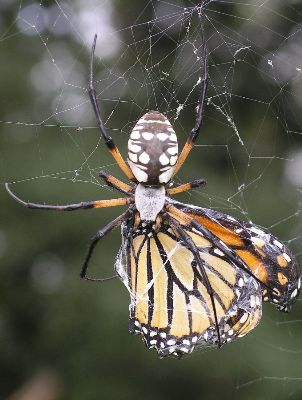by Valerie
October, 2004Black and Yellow Argiope Boasting hues appropriate to the season, the black and yellow argiope (Argiope aurantia) pictured at left is dining on a color coordinated meal: an unfortunate monarch butterfly. One of the most spectacular of our spiders, the argiope (rhymes with calliope) is known by a number of different names, including garden spider, golden orb weaver, writing spider, banana spider, and zipper spider. Although there are several spiders in the genus Argiope, most are restricted to tropical areas. By contrast, the black and yellow argiope is found throughout the United States.
Boasting hues appropriate to the season, the black and yellow argiope (Argiope aurantia) pictured at left is dining on a color coordinated meal: an unfortunate monarch butterfly. One of the most spectacular of our spiders, the argiope (rhymes with calliope) is known by a number of different names, including garden spider, golden orb weaver, writing spider, banana spider, and zipper spider. Although there are several spiders in the genus Argiope, most are restricted to tropical areas. By contrast, the black and yellow argiope is found throughout the United States.
We usually have at least one resident argiope in our yard each summer. Because we provide a lot of good habitat for various creatures, it has turned out that the larger spiders have a difficult time surviving due to the number of birds that also enjoy our yard. Once an argiope has set up its web, it is easy to observe because it pretty much stays put. Consequently, whenever I find a young argiope, I visit it often to check on its progress throughout the warm months. This rule only applies to females, however, as the males must eventually move off in search of a mate. Quite early this past spring, a tiny argiope built its web in our cactus garden. After a couple of weeks it was obvious that this was a male and, as soon as he was old enough, he disappeared on his life's mission. Shortly afterwards, I noticed a very young female in one of our backyard gardens. I was able to watch her as she grew bigger and adjusted her web site several times. Argiopes are easy to approach because they have poor eyesight and respond to any nearby movement by remaining still. Never moving far from her original location, she eventually occupied a web about three feet across. I checked on our argiope regularly and was pleased when she survived a rather torrential rainstorm. In the past, I've seen these spiders killed by heavy rains and/or hail. She suddenly moved her web just before she laid her first egg case. Black and yellow argiopes, unlike many other orb weavers, do not remove and rebuild their webs on a daily basis. They only do needed repairs, so it must be quite an undertaking for them to move their residence. After an argiope lays eggs, she often acts very lethargic and tired and, indeed, looks pretty worn out with her sagging and wrinkly abdomen. If conditions are good, the spider then sets about eating again, regaining her strength, and lays subsequent clutches of eggs. This can be repeated at least 4 times. Unfortunately, shortly after our spider laid her eggs, she disappeared, along with the middle part of her web, almost a sure sign that a bird had found her to be an easy meal. |
(More information on argiopes is available in "larvalbug's garden.")